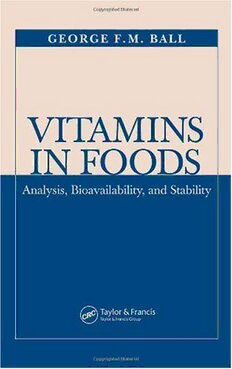
Vitamins in foods: analysis, bioavailability, and stability PDF
814 Pages·2005·10.12 MB·English
Most books are stored in the elastic cloud where traffic is expensive. For this reason, we have a limit on daily download.
Preview Vitamins in foods: analysis, bioavailability, and stability
Description:
To achieve and maintain optimal health, it is essential that the vitamins in foods are present in sufficient quantity and are in a form that the body can assimilate. Vitamins in Foods: Analysis, Bioavailability, and Stability presents the latest information about vitamins and their analysis, bioavailability, and stability in foods. The contents of the book is divided into two parts to facilitate accessibility and understanding. Part I, Properties of Vitamins , discusses the effects of food processing on vitamin retention, the physiology of vitamin absorption, and the physiochemical properties of individual vitamins. Factors affecting vitamin bioavailability are also discussed in detail. The second part, Analysis of Vitamins , describes the principles of analytical methods and provides detailed methods for depicting individual vitamins in foods. Analytical topics of particular interest include the identification of problems associated with quantitatively extracting vitamins from the food matrix; assay techniques, including immunoassays, protein binding, microbiological, and biosensor assays; the presentation of high-performance liquid chromatography (HPLC) methodology illustrated in tables accompanied by step-by-step details of sample preparation; the explanation of representative separations (chromatograms) taken from original research papers are reproduced together with ultraviolet and florescence spectra of vitamins; the appraisal of various analytical approaches that are currently employed. Comprehensive andcomplete, Vitamins in Foods: Analysis, Bioavailability, and Stability is a must have resource for those who need the latest information on analytical methodology and factors affecting vitamin bioavailability and retention in foods.
See more
The list of books you might like
Most books are stored in the elastic cloud where traffic is expensive. For this reason, we have a limit on daily download.
